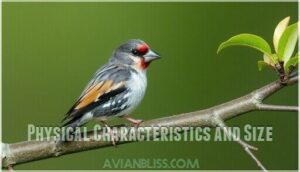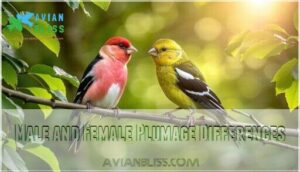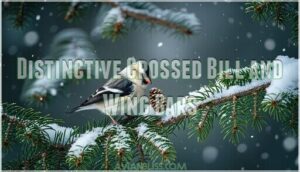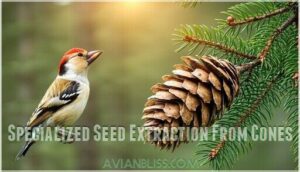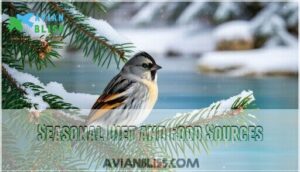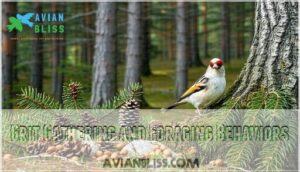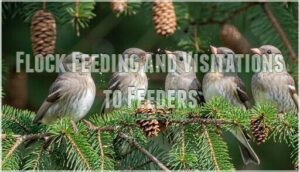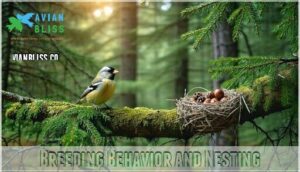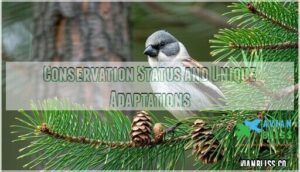This site is supported by our readers. We may earn a commission, at no cost to you, if you purchase through links.
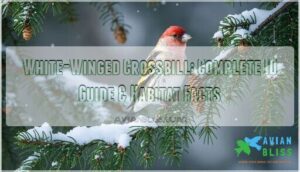
They’re nomadic wanderers following spruce cone crops across boreal forests, consuming up to 3,000 seeds daily with their specialized bills. Unlike predictable migrants, crossbills appear unexpectedly during irruptive years when northern cone crops fail. Their opportunistic breeding happens year-round whenever food’s abundant, making timing as unpredictable as their movements.
These remarkable adaptations reveal fascinating survival strategies. Their ability to thrive in various conditions, such as nomadic wanderers, is a key aspect of their unique behavior.
Table Of Contents
- Key Takeaways
- White-winged Crossbill Identification
- Habitat and Geographic Range
- Feeding Habits and Diet
- Breeding Behavior and Nesting
- Conservation Status and Unique Adaptations
- Frequently Asked Questions (FAQs)
- What is the difference between Red Crossbill and white winged crossbill?
- How big are White-winged Crossbills?
- What is the difference between a house finch and a crossbill?
- Where do crossbill birds live?
- Do white-winged crossbills migrate?
- What do their nests look like?
- How do they behave during courtship?
- How many young do they raise?
- What do they sound like?
- What sounds do white-winged crossbills make?
- Conclusion
Key Takeaways
- You’ll recognize white-winged crossbills instantly by their crossed bill tips and bold white wing bars – males sport rose-pink bodies while females display olive-yellow tones.
- These nomadic finches consume up to 3,000 conifer seeds daily using their specialized bills like nature’s pliers, following spruce cone crops across boreal forests unpredictably.
- They’re opportunistic breeders who nest year-round whenever food’s abundant rather than following seasonal patterns, making their timing as unpredictable as their movements.
- You’ll witness dramatic population swings during irruptive years when northern cone crops fail, causing massive southward movements that can bring flocks thousands of miles from their normal range.
White-winged Crossbill Identification
You’ll recognize a White-winged Crossbill by its unique crossed bill tips and bold white wing bars that flash during flight.
These compact finches show striking differences between males and females, with bright pink-red males contrasting against yellow-green females, and the bold white wing bars are a notable feature.
Physical Characteristics and Size
You’ll spot this compact finch measuring 15-17 cm with distinctive beak structure perfectly crossed for seed extraction. Its body proportions appear stocky with a 26-28 cm wing span and slightly forked tail length. Bird size comparison places it between Pine Siskin and Pine Grosbeak.
The whitewinged crossbill displays unique relative size characteristics making bird measurements essential for identification. Accurate bird identification using physical features analysis is essential for distinguishing between similar species, and understanding physical features is key.
Male and Female Plumage Differences
You’ll notice dramatic Sex Dimorphism in Whitewinged Crossbill Plumage Coloration that makes Bird Species Identification straightforward. Adult males showcase striking Color Pattern differences from their female counterparts in this unique Finch Species.
Key plumage differences include:
- Males display rose-pink to red bodies with contrasting black wings and tail
- Females show yellowish-green or olive tones with darker wing markings
- Both sexes maintain bold white wing bars as their signature Feather Patterns
These distinct Bird Identification markers help distinguish breeding adults easily in the field.
Distinctive Crossed Bill and Wing Bars
The crossed-bill structure makes White-winged Crossbills nature’s lock-picking specialists. You’ll recognize their overlapping mandibles that twist left or right, perfectly adapted for prying open conifer cones.
The distinctive bill structure and wing bar patterns make Loxia leucoptera identification straightforward during crossbill behavior studies. Bold white wing bar patterns create striking contrast against dark wings in both sexes. This beak adaptation allows access to seeds other birds can’t reach.
Age and Subspecies Variations
Young White-winged Crossbills wear duller plumage than adults, resembling females with streaky brown-yellow coloring. Juvenile Development progresses gradually over several months.
The Subspecies Comparison reveals Loxia leucoptera has two distinct forms: North American leucoptera and Eurasian bifasciata.
- Age Related Traits: Juveniles lack the vibrant reds and pinks of adult males
- Plumage Variation: Eurasian birds show less black coloring than American cousins
- Morphological Differences: Bifasciata subspecies displays larger bills for tougher cones
- Regional Differences: Crossbill Behavior Studies document unique songs between populations
Habitat and Geographic Range
You’ll find White-winged Crossbills in coniferous forests across North America and Eurasia, where spruce and fir trees produce the cones they depend on.
These nomadic birds move unpredictably based on cone crop availability, creating irregular irruptions that can bring them far south of their normal boreal range.
Preferred Coniferous Forests
Where do these resilient birds call home? White-winged Crossbills thrive in mature spruce-dominated boreal zones, particularly targeting Engelmann spruce and subalpine fir forests. These coniferous forest birds depend entirely on conifer seed availability from spruce cones.
Forest ecosystems with tree species diversity support stable populations, while habitat fragmentation threatens biodiversity conservation efforts for specialized seed-extractors like crossbills. The birds’ survival is closely tied to their conifer preferences and the availability of specific conifer seed availability from spruce cones, which is crucial for their survival.
North American and Eurasian Distribution
White-winged Crossbills showcase remarkable avian geographic distribution across two major continents. You’ll find these Northern Woods Birds spanning vast territories with distinct subspecies variation that reflects their specialized habitat preferences.
Migration Patterns and Geographic Range:
- North American leucoptera – Alaska through eastern Canada, extending into northern U.S. Rocky Mountains and Great Lakes region
- Eurasian bifasciata – Scandinavia through Siberia, often called "Two-barred Crossbill" with larger bills
- White Mountains stronghold – New Hampshire’s western highlands serve as primary nesting areas
- Coniferous Forest Birds – Distribution follows spruce, tamarack, and fir forest boundaries
- Global Movement patterns – Circumpolar range connects northern and montane coniferous forests worldwide
Understanding the importance of native bird habitats is essential for conservation efforts and protecting these species.
Irruptive Movements and Nomadic Patterns
You’ll witness some of nature’s most dramatic Food Supply Dynamics when white-winged crossbills suddenly appear in your area. These Irruptive Bird Species follow unpredictable Migration Patterns driven entirely by Seed Availability. Major irruptive movements occur roughly every decade, with flocks traveling thousands of miles when conifer cone crops fail.
This Nomadic Behavior creates wild Population Fluctuations as crossbill behavior shifts instantly based on conifer cone dependence, making bird migration patterns fascinating yet challenging to predict. The unique beak adaptations of white-winged crossbills are influenced by their crossbill species characteristics that aid in extracting seeds from cones.
Feeding Habits and Diet
You’ll discover that White-winged Crossbills possess one of nature’s most specialized feeding tools. Their crossed bills work like precision pliers to extract seeds from tightly closed conifer cones.
Specialized Seed Extraction From Cones
The specialized crossed bill structure transforms these birds into nature’s ultimate cone-cracking machines. Watch how crossbills work their magic on tough conifer cones:
- Twisted mandibles pry cone scales apart with surgical precision
- Flexible tongue extracts seeds from deep chambers
- Sideways head tilts maximize leverage and access angles
- Rapid-fire movements consume up to 3,000 seeds daily
Their Bill Structure Adaptations represent millions of years of Foraging Strategy Evolution, making Seed Access Specialization possible where other birds fail completely. The crossbill’s unique ability to extract seeds is also supported by tools like a Crossbill Seed extractor.
Seasonal Diet and Food Sources
Throughout the year, you’ll notice dramatic shifts in these finches’ feeding behavior and diet. Winter brings intense focus on spruce and tamarack seeds—up to 3,000 daily per bird. Summer expands their menu to include protein-rich insects like spruce budworm, ants, and spiders.
Seed Availability drives their Foraging Strategies, with Dietary Adaptations enabling survival during Cone Crops failures through alternative conifer seeds and occasional weed consumption. Understanding the basics of bird feeding habits is essential for creating an effective bird-friendly environment.
Grit Gathering and Foraging Behaviors
You’ll often spot these finches gathering grit from exposed soil and road cuts. Their adaptive foraging strategies include consuming up to 3,000 conifer seeds daily through specialized seed extraction methods.
They prefer spruce and tamarack cones but show flexible conifer seed preferences during scarce times. Grit consumption aids digestion of their seed-heavy diet, supporting their remarkable feeding behavior patterns.
Flock Feeding and Visitations to Feeders
You’ll spot these irruptive Finches moving through forests in tight flocks during cone crop years. Their Group Synchronization creates mesmerizing waves of activity as they work conifers systematically. Whitewinged Crossbill flocks rarely visit traditional feeders, preferring natural Seed Selection from spruce and pine cones over sunflower seeds.
- Flock Dynamics: Groups of 5-50 birds move together, coordinating their Foraging Strategies across cone-laden branches
- Feeder Preferences: Occasionally visit feeders with pine nuts or nyjer seed during irruption years when natural food sources are scarce
- feeding behavior and diet: Flocks can strip an entire tree of cones in hours, consuming thousands of seeds daily per bird
- seed consumption habits: Groups work methodically through forest patches, following cone abundance patterns that trigger their nomadic lifestyle
When natural food is scarce, they may visit Pine Nut Feeders to supplement their diet.
Breeding Behavior and Nesting
White-winged Crossbills breed whenever cone crops are abundant, making them one of the few birds that can nest year-round.
You’ll find their loose colonies in spruce forests where pairs build cup-shaped nests on horizontal branches 10 to 70 feet above ground.
Opportunistic and Year-round Breeding
White-winged Crossbills don’t follow typical bird calendars. These nomadic finches breed whenever spruce cones are abundant. You’ll find their breeding strategies tied directly to food availability rather than seasons.
Nature’s lock-pickers breed when the buffet is open, not when the calendar says so
| Breeding Trigger | Timing | Success Rate |
|---|---|---|
| Heavy cone crops | Any season | High nesting success |
| Moderate cone supply | Spring peak | Variable fledgling survival |
| Poor cone years | Breeding delayed | Low reproductive success |
Loxia leucoptera’s reproductive adaptations let them capitalize on unpredictable food sources. Males court females while cone crops last. This irruptive species links mate selection to feeding opportunities. Their flexible breeding cycle maximizes offspring survival when resources peak.
Nesting Sites and Colony Formation
You’ll find these birds forming loose colonies during breeding season, especially when spruce cone crops are abundant. Their nest architecture follows specific patterns that maximize nesting success within their chosen breeding territories.
Key colony dynamics include:
- Horizontal branch selection – 10-70 feet above ground on sturdy conifer limbs
- Loose clustering – Multiple pairs nest within hearing distance but maintain space
- Adaptive spacing – Colony density varies based on food availability and habitat quality
- Seasonal timing – Groups coordinate breeding attempts when cone resources peak
These Whitewinged Crossbill colonies shift locations yearly following food sources. Wildlife habitat management efforts focus on preserving mature coniferous forests that support their unique breeding territories and fledging patterns. Conservation efforts often involve installing bird nesting boxes to support local bird populations.
Egg Laying, Incubation, and Parental Care
Female crossbills lay 2-4 whitish eggs with brown spots. You’ll notice males feed females during the 12-14 day incubation period.
Both parents share fledgling care duties, with males often taking over while females start new broods. This parental role division maximizes breeding success during peak cone seasons. Nesting behavior adapts to food availability patterns.
Population Changes Linked to Cone Crops
Cone crop cycles dictate White-winged Crossbill populations like a natural roller coaster. You’ll witness dramatic swings based on seed availability across boreal forests.
Population Dynamics Include:
- Boom years during heavy spruce cone production increase breeding success
- Bust cycles trigger mass movements when food supply chains collapse
- Regional synchronization creates predictable abundance patterns
- Climate change threatens traditional cone crop fluctuations affecting wildlife conservation efforts
These ecological interactions shape crossbill survival strategies.
Conservation Status and Unique Adaptations
White-winged Crossbills maintain stable global populations despite their nomadic lifestyle and specialized habitat needs.
You’ll find these remarkable birds have evolved unique crossed bills and flexible breeding patterns that help them thrive in changing conifer forests worldwide.
IUCN Listing and Population Estimates
Despite their nomadic nature, White-winged Crossbills maintain secure Global Rankings with Least Concern conservation status. The IUCN recognizes stable Population Trends across their range. Partners in Flight estimates 79 million individuals globally, with Canada hosting nearly half.
This Species Vulnerability assessment reflects no immediate Threat Assessment concerns, though Christmas Bird Count data shows populations fluctuate with cone crops. The conservation of bird species like the White-winged Crossbill relies on understanding habitat loss factors to develop effective protection strategies.
Vulnerability to Habitat Loss and Climate Change
Why should you worry about White-winged Crossbill survival? Climate change threatens their boreal forest habitat through ecosystem disruption and altered seed availability.
Habitat fragmentation reduces mature cone-producing trees essential for breeding. Conservation efforts focus on protecting old-growth forests as climate shift impacts force range relocations.
Their conservation status reflects increasing vulnerability to environmental changes, including climate change and habitat fragmentation.
Notable Behaviors and Evolutionary Adaptations
You’ll witness remarkable evolutionary adaptations in White-winged Crossbills that showcase millions of years of species evolution. Their crossed bills represent perfect Beak Evolution for Seed Specialization, allowing precise Crossbill Foraging that other birds can’t match.
Flocking Behavior enables efficient resource sharing during Adaptive Migration. These wildlife adaptation strategies help crossbills consume 3,000 seeds daily, demonstrating specialized Behavior perfectly captured in Whitewinged Crossbill Photos documenting their unique feeding techniques.
Regional and Subspecies Differences
You’ll find two recognized subspecies with distinct characteristics. North American Whitewinged Crossbill (Loxia leucoptera leucoptera) differs from Eurasian Two-barred Crossbill (L. l. bifasciata) through Geographic Isolation and Bill Morphology variations. The Eurasian subspecies shows larger bills and reduced black plumage.
Plumage Diversity reflects Genetic Differences between populations. Some researchers consider them separate species entirely. These Subspecies Variation patterns mirror other Crossbill populations, supporting ongoing Avian Ecology Research into Bird Species Conservation strategies across fragmented ranges.
Frequently Asked Questions (FAQs)
What is the difference between Red Crossbill and white winged crossbill?
These crossbills are absolutely mind-blowing different! You’ll spot White-winged Crossbills by their distinctive white wing bars that Red Crossbills completely lack.
Red Crossbills also have slightly larger bills for cracking different cone types, and are distinct from the Red Crossbills mentioned earlier.
How big are White-winged Crossbills?
You’ll encounter these compact finches measuring 9-7 inches long with 2-0 inch wingspans. They’re slightly larger than Pine Siskins but smaller than Pine Grosbeaks, weighing just 8-9 ounces with stocky builds.
They have the described measurements and weights.
What is the difference between a house finch and a crossbill?
Ever wondered why some finches have such unusual bills?
You’ll spot the key difference right away – crossbills have crossed mandibles for prying open cones, while house finches sport straight, seed-cracking bills for general feeding.
Where do crossbill birds live?
You’ll spot these specialized finches roaming coniferous forests across North America and Eurasia. They’re nomadic wanderers, following cone crops from Alaska to eastern Canada, shifting locations based on food availability rather than seasons.
Do white-winged crossbills migrate?
You’ll find these birds don’t truly migrate like other species. Instead, they’re nomadic wanderers who follow cone crops across coniferous forests, moving unpredictably based on food availability rather than seasons.
What do their nests look like?
Home truly is where the heart builds.
You’ll discover cup-shaped nests tucked on horizontal conifer branches, ten to seventy feet high.
Females craft these cozy structures using twigs, moss, and soft materials like hair for lining comfort, which makes their nests a cozy structure.
How do they behave during courtship?
During courtship, you’ll see males perform aerial displays while singing their jumbled, high-pitched songs. They’ll feed females directly, passing seeds bill-to-bill in an intimate bonding ritual that strengthens their pair bond before breeding.
How many young do they raise?
You’ll typically see them raise 2-4 eggs per clutch, though they can lay up to They’re capable of multiple broods yearly when cone crops are abundant, maximizing their reproductive success.
What do they sound like?
You’ll hear their song as a series of jumbled, high-pitched notes that males deliver from treetops. Their calls create a melodic chatter that’s distinctly musical yet chaotic-sounding.
What sounds do white-winged crossbills make?
You’ll hear males singing series of jumbled, high-pitched notes from treetops, even during winter months. Their vocalizations include flight calls and contact notes while foraging in flocks.
Conclusion
Twenty percent of white winged crossbill populations can shift locations within a single season, demonstrating their remarkable adaptability. You’ll find these specialized finches thriving through their crossed bills and nomadic lifestyle.
Their unpredictable movements follow food sources across vast boreal regions. Understanding the white winged crossbill helps you appreciate nature’s creative solutions to survival challenges. These birds prove adaptation drives success in changing environments, showcasing their ability to thrive in various conditions through their nomadic lifestyle.
- https://www.allaboutbirds.org/guide/White-winged_Crossbill/id
- http://www.minnesotaseasons.com/Birds/White-winged_Crossbill.html
- https://academy.allaboutbirds.org/white-winged-crossbill-foraging-adaptation/
- https://www.birdatlas.bc.ca/accounts/speciesaccount.jsp?lang=en&sp=WWCR
- https://www.sdakotabirds.com/species/white_winged_crossbill_info.htm

